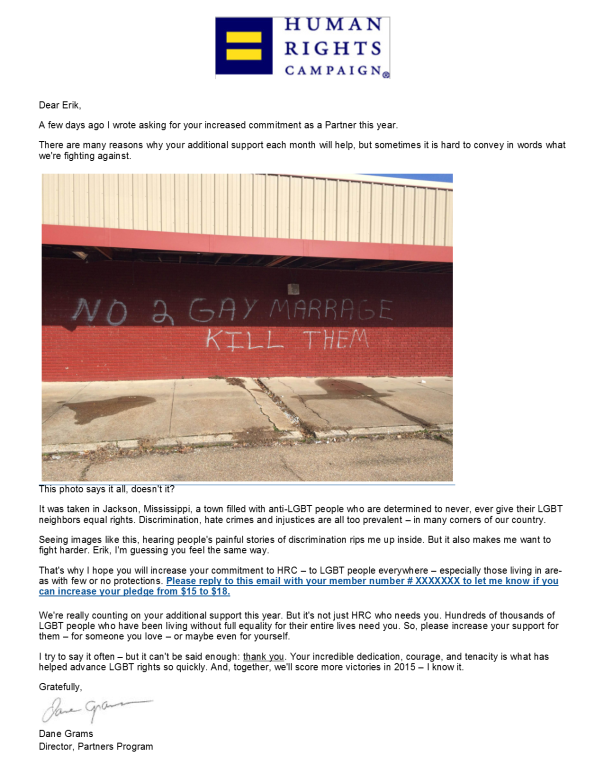On January 8th, I wrote a post titled “Fundraising New Year’s Resolution — Upgrade Strategy,” which contained a few tips about how your non-profit organization can achieve this important strategy. After writing that post, I wished that I had a sample to share with you . . . and then a few weeks ago I received an email from Dane Grams at Human Right Campaign (HRC).

Did you notice the following:
- The case for support was simply captured without saying a word? A picture is worth a 1,000 words!
- Philanthropy is an emotional activity and the case evoked lots of emotion.
- He didn’t bombard me with lots of stats. He didn’t try to tell me how often this type of thing happens in America. He simply pulled an emotional trigger and got out of the way.
- He asked for a specific dollar amount increase.
- He made it easy to say YES . . . just click the link.
- He thanked me for my ongoing support and participation in their monthly giving program.
Tom Ahern, one of our country’s smartest donor communications experts, says all the time that good appeals contain at least one of the following emotional triggers:
- anger
- exclusivity
- fear
- flattery
- greed
- guilt
- salvation
How many of those triggers can you see in the letter above?
If you want to learn how to get better at donor communications, I suggest checking out Tom Ahern’s books, videos and resources. If you want to learn more about monthly giving programs, Pamela Grow has a really nice four week distance learning online course. If you want to get better at creating upgrade opportunities, keep your eyes open because some of your peers in the non-profit sector have gotten really good at it. As I say in many of my blog posts . . . we can learn from each other!
I’m sure you’re wondering if I clicked that upgrade button. You’re damn straight I did! I didn’t even think twice about doing it, which is how I know it was a very effective appeal.
Have you seen a really good upgrade strategy (e.g. mail, email, etc)? Please feel free to email it to me, and I’ll be happy to share it with the rest of the DonorDreams blog community. I will, of course, scrub it of your personal into and protect your identity.
Please scroll down and share your thoughts and experiences in the comment box below.
Here’s to your health!
Erik Anderson
Founder & President, The Healthy Non-Profit LLC
www.thehealthynonprofit.com
erik@thehealthynonprofit.com
http://twitter.com/#!/eanderson847
http://www.facebook.com/eanderson847
http://www.linkedin.com/in/erikanderson847



